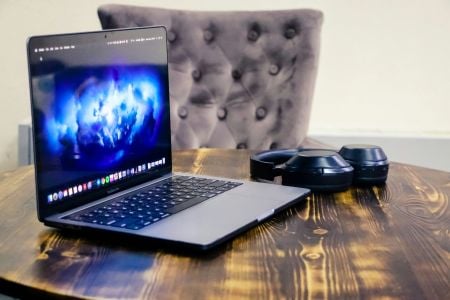A lot of us search the laptop specifications list on Google, especially when it’s time to buy a new one, whether for study, work, or even gaming. Let's break down that scary laptop specifications list one by one. Think of it like choosing ingredients for your favourite nasi lemak – each one plays a part!

Editor
Mae An NG chevron_right
Table of Contents
Laptop Specs Explained: A Beginner's Guide

The Brain: CPU (Central Processing Unit)
Okay, imagine the CPU is the otak (brain) of your laptop. It does all the thinking and processing. The faster the brain, the smoother your laptop runs, especially when you open many apps at once.
Common Brands: You'll mostly see Intel (Core i3, i5, i7, i9) or AMD (Ryzen 3, 5, 7, 9).
What to look for:
- For daily tasks (browsing, Word, Excel, Netflix): Intel Core i3 or AMD Ryzen 3 is usually enough.
- For everyday use, some photo editing, and light gaming: Intel Core i5 or AMD Ryzen 5 is a great all-rounder.
- For heavy tasks (video editing, serious gaming, programming): Intel Core i7/i9 or AMD Ryzen 7/9 will give you the power you need.
Generation Matters: Newer generations (like Intel 13th Gen or AMD Ryzen 7000 series) are generally better than older ones. So, a newer i5 might even beat an older i7 sometimes!
The Workspace: RAM (Random Access Memory)
RAM is your laptop’s short-term memory. The more RAM, the smoother your laptop will run, especially if you like to open many tabs at once (we know you do!).
How much do you need?
- 4GB RAM: Okay for very basic tasks, but you might feel it slow down quickly. Not really recommended nowadays.
- 8GB RAM: This is the new minimum for most people. Good for smooth multitasking – like having your assignment open, Spotify playing, and a few Chrome tabs.
- 16GB RAM: Awesome for those who open TONS of tabs, do video editing, or play modern games. Future-proof!
- 32GB RAM & above: For professionals and serious gamers.
Keyword tip: If you’re checking a laptop specifications list, always look for RAM first!
The Storeroom: Storage (SSD vs. HDD)
This is where your laptop keeps all your files: your operating system (like Windows), software, photos, videos, and assignments.
Two main types:
- HDD (Hard Disk Drive): Older technology. Slower, but you get more storage for less money. Good for storing lots of big files you don't access often.
- SSD (Solid State Drive): Newer, MUCH faster! Your laptop will boot up in seconds, apps will open quickly. A bit more expensive for the same amount of space, but worth every sen!
NVMe SSD: Even faster than a regular SSD. If you see this, it's a big plus!
Our advice? Always, always try to get a laptop with an SSD as its main drive. Even a smaller SSD (like 256GB) for your operating system and main apps, with an external HDD for extra storage, is better than just a big HDD.
How much space?
- 256GB SSD: Okay if you store most things in the cloud or an external drive.
- 512GB SSD: A good sweet spot for most users. Plenty of room for your OS, apps, and quite a few files.
- 1TB SSD or more: If you have lots of games, videos, or big project files.
The Artist: GPU (Graphics Processing Unit)
The GPU, or graphics card, is all about visuals. Not everyone needs this, but if you're into gaming, photo/video editing, or design, this is super important. There are two types:
Integrated Graphics:
- This is built into the CPU (like Intel Iris Xe Graphics or AMD Radeon Graphics).
- Good enough for everyday tasks, watching HD/4K videos, and very light gaming.
- Uses less power, so better battery life.
Dedicated/Discrete Graphics:
- A separate, more powerful chip (usually from the NVIDIA GeForce or AMD Radeon RX series).
- Essential if you want to play modern games, do serious video editing, 3D modelling, or other graphics-heavy work.
- It will consume more battery.
So, if you just need a laptop for work or study, integrated graphics are fine. If you're a gamer or creative pro, look for a dedicated GPU!

The Window: Display (Screen)
Size matters! Especially if you’re watching dramas, doing assignments, or playing games.
You'll be staring at this all day, so it's important!
Common sizes:
- 13-14 inch: Great for portability. Easy to carry around to class or cafes.
- 15.6 inch: The most common size. Good balance of screen space and portability.
- 17 inch & above: More like a desktop replacement. Great for gaming or if you need lots of screen real estate, but heavy.
Resolution: This means how sharp the picture is.
- HD (1366x768): You might still find this on cheaper laptops. It's okay, but text and images won't be very sharp. Try to avoid it if you can.
- Full HD (FHD / 1920x1080): This is the sweet spot for most laptops. Everything looks clear and crisp. This should be your target!
- QHD (2560x1440) or 4K (3840x2160): Super sharp, amazing for creative work or watching 4K movies. But, they use more battery and can make things look tiny if the screen isn't big enough.
Practical tip: If your laptop specifications list doesn’t say Full HD, don’t buy it!
Panel Type: IPS panels generally offer better colours and viewing angles than TN panels. OLED panels are gorgeous with deep blacks, but can be pricey.
Refresh Rate: Measured in Hertz (Hz). The standard is 60Hz. Gamers will want 120Hz, 144Hz, or even higher for smoother gameplay.
The Stamina: Battery Life
Manufacturers will state "up to X hours" of battery life. Take this with a pinch of salt, as real-world usage is usually less.
- Look at the battery capacity (measured in Wh – Watt-hours). A bigger number is generally better.
- But, how long it lasts also depends on your usage, screen brightness, and other specs (e.g., a powerful GPU will drain battery faster).
If you're always on the go, look for laptops known for good battery life. Check reviews!

Other Important Specs
Ports and Connectivity: Think about what you need to plug into your laptop.
- USB-A: The classic rectangular port for your mouse, keyboard, pendrive.
- USB-C: Smaller, oval-shaped. Newer and faster. Many modern devices use this. Some USB-C ports also support charging the laptop (Thunderbolt is a super-fast type of USB-C).
- HDMI: To connect to an external monitor or TV.
- SD Card Reader: Useful if you're a photographer or videographer.
- Headphone Jack: Still important for many!
- Wi-Fi: Look for Wi-Fi 6 or Wi-Fi 6E for the latest and fastest wireless connection.
- Bluetooth: For connecting wireless headphones, mouse, etc.
Keyboard – Look for a backlit keyboard if you work at night.
Weight – Below 1.5kg is light and easy to carry around.
Build Quality – Metal feels better, but plastic is lighter and cheaper.
Final Thoughts
There you have it! A simple and complete guide to understand a laptop specifications list like a pro. If you’re shopping for the best laptop, just remember to check:
- Processor
- RAM
- Storage
- Battery life
Next time you see those tech terms, you won’t feel blurry anymore. That way, you’ll get the best value for your money. No need to overspend on something you don’t need. And hey, once you've narrowed down your choices, you can always check out our detailed reviews here on ProductNation for more local insights!
P/S: Share this with your friend or cousin who always asks “Eh bro, which laptop is good?”
